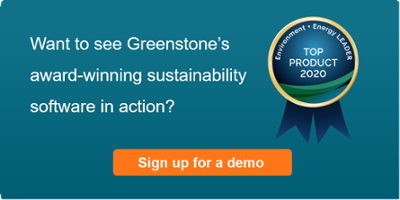Reporting the impact of COVID-19 in your climate change disclosures
 The global COVID-19 pandemic is set to cause the largest ever annual fall in greenhouse gas (GHG) emissions due to the dramatic change in the way we all have lived and worked over the past year. However, the fluctuation in climate data has been a huge challenge for those responsible for their organisation’s sustainability reporting.
The global COVID-19 pandemic is set to cause the largest ever annual fall in greenhouse gas (GHG) emissions due to the dramatic change in the way we all have lived and worked over the past year. However, the fluctuation in climate data has been a huge challenge for those responsible for their organisation’s sustainability reporting.
Greenstone recently presented at the Global Reporting Initiative (GRI)’s Virtual Summit on how to report the impacts of COVID-19 in climate change disclosures. In this blog, Greenstone reflects on the impact that COVID-19 has had so far on climate change disclosures, some of the key challenges that companies are facing, and some solutions that we are seeing from our work at Greenstone, and the industry generally.
Changes in climate data
The dramatic change in climate data is creating a huge challenge for sustainability reporters who are having to adapt to a significantly shifting year of data. Here is an overview of some of the key impacts that COVID-19 has had on climate reporting so far:
- Office Closures - many offices and other workplaces have had to shut, either temporarily or in some cases, This has meant that environmental data has been massively impacted, with utility usage, in particular energy consumption, from corporate buildings plummeting.
- Working from home - should we be accounting for the environmental impact of home working in our sustainability reports? This is a question we are being asked almost daily.
- Business travel – intrinsically linked to the points above, all but essential business travel and employee commuting have been eliminated, significantly cutting a major environmental impact area for many organisations.
- The shift in material data categories - as COVID has resulted in so many far-reaching issues across the world, what is deemed to be a material sustainability topic area is shifting all the time. As just one example, employee well-being is being pushed to the top of many businesses’ materiality assessments this year.
- Reassessment of targets and baselines – organisations are being forced to review their reduction targets and baseline years. When the post-COVID world arrives, it is clear that we will not just switch straight back to what it was like in 2019; there are going to be huge differences in the way we operate as a business community which means previous climate goals may not be as relevant.
Three data challenges that sustainability reporters now face
With all of these impacts in mind, how do reporters maintain best-practice whilst producing transparent and meaningful insights? Below are the three main challenges we see our clients facing and some solutions to address them.
1. Collecting complete climate data sets
Due to office closures, reduced workforces and general resources being cut, it is becoming harder to collect reliable data. Availability of information and the challenge of collecting reliable data sets during COVID periods is becoming apparent.
At Greenstone, we are certainly seeing this challenge; a number of our clients are now relying more on our software functions to achieve accuracy and coverage. This includes the modelling function which automatically identifies gaps in your environmental data and plugs them with a defined estimation methodology. And because the routine is dynamic, accuracy increases as more actual values from across your sites are obtained during COVID periods, ensuring that the reduction in consumption whilst offices are not fully operational is taken into account.
This is one example of how companies are adapting to the current difficulty in data collection, but the key takeaway is to ensure that you maintain complete coverage of data in the most accurate way possible. And utilise the available tools to enable you to do this.
2. Quantifying the impact of your employees who are working from home
Although there is not currently a dedicated category in the GHG Protocol Corporate Standard for home working emissions, it does fall under ‘Category 7: Employee Commuting’ of the Scope 3 guidance. This means it is still a formal and recognised part of an organisation’s environmental boundary. And because now more than ever the impact of this category is material to most companies, we are seeing an increased focus on this area in corporate reporting.
But how do organisations quantify and calculate the impact of employees working from home? It is not entirely straight forward and, unfortunately, there is currently limited guidance available. As with all-climate reporting, the most accurate method involves the collection of reliable data from all locations. Some organisations have taken this approach, surveying employees on their individual home environments to understand how many have a renewable energy supply, how many other people they live with etc. However many sustainability teams do not have the resource or processes in place to undertake such an exercise, and some understandably do not want to subject their employees to another survey. Such organisations are therefore utilising publicly available resources, for example, those which provide detailed breakdowns of average domestic consumption in different markets.
To summarise, accounting for the impact of home working is a great thing to do and helps companies achieve complete and transparent reporting. Whilst this process can involve a very detailed and extensive data collection method, organisations should look for and utilise the available resources where needed.
3. Accounting for changes in climate data in sustainability reports
To date, COVID has not yet become a widespread area that is being included in the climate sections of sustainability reports. This is understandable as most reports which are going to cover COVID time periods have not yet been published.
However, as 2020 reports are finalised and start to come out next year, it will be essential for clear communications to be included to explain the impact that COVID has had on climate data. This has been a clear focus area across our clients in recent months, with software functions including the Variance Tracker being used to record detailed narratives alongside specific environmental trends.
Greenstone’s sustainability software – Variance Tracker
Greenstone’s Enterprise sustainability software contains a dedicated Variance Tracker which allows users to run queries on material consumption variances in their data sets. This gives companies a clear oversight of data fluctuations and a central system for classifying reasons for the changes, both for internal analysis and for external assurances. This year, we have seen our clients add new classifications for ‘site closures’ and ‘site restrictions’ to capture variances associated with COVID-19. This has ensured that organisations have been able to clearly identify and account for specific trends in an ever-shifting year, whilst preparing for climate and wider sustainability reporting.
You can now watch on-demand our webinar on: 'Reporting the impacts of COVID-19 in your environmental reports'.
For more information on this, please talk to the Greenstone team.










